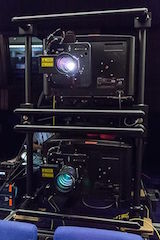“At 120 frames per second your eyes get greedy,” said Hollywood film director Ang Lee at the first European showing of footage from his latest film, Billy Lynn’s Long Halftime Walk. There were other firsts, as the movie was screened at 120fps, in 4K 3D, at 28 foot-lamberts per eye brightness. The presentation was the keynote at this year’s IBC Big Screen Experience. Long-standing show director Julian Pinn opened the session promising, “I don’t think I’m exaggerating when I say this is cinema history in the making.” Pinn added that the clips would be shown on the Christie Mirage, calling it the only projector capable of showing 120fps, 3D, 4K at 28 foot-lamberts.
On stage for the discussion, in addition to Ang Lee and Pinn, were the film’s technical supervisor, Ben Gervais; editor Tim Squyres; and Scot Barbour, head of production technology, Sony Pictures Entertainment. For the nine-minute clip, the two Christie Mirage 4KLHs, the laser-light powered version of the original Xenon-lamp based Mirage, were installed in the auditorium, and a team of Christie engineers supported the screenings.
Lee is known for both his dramatic storytelling and his embracing of new technologies, such as his 3D Life of Pi. Lee said the production team had decided to make the film in 120fps because high frame rate removes many of the limitations associated with 24fps 3D.
Gervais said, “We never necessarily intended to see this film that way because none of us had ever seen [120fps, 4K] and finally one week before shooting we managed to get a set of [Mirage] projectors from Christie and all of us were awestruck. We hadn’t seen anything like it before.”
 They started shooting and Squyres, the movie’s editor said, “I had to cut at the highest resolution I could, which was 60fps. We were on the edge of what the system could do. Then Christie came in with the Mirages; they brought the Christie projectors into our editing room. We had the best screening room on the planet. Ideally we wanted to see it as near as possible to how it was shot.”
They started shooting and Squyres, the movie’s editor said, “I had to cut at the highest resolution I could, which was 60fps. We were on the edge of what the system could do. Then Christie came in with the Mirages; they brought the Christie projectors into our editing room. We had the best screening room on the planet. Ideally we wanted to see it as near as possible to how it was shot.”
Being able to see what they were shooting daily in 120fps 4K had immediate impact during the shoot as Lee explained, referencing scenes set in Iraq: “We could see everything in that burning sunlight. We saw we couldn’t use make-up. That’s the scary part; you see the acting. Most preciously to me were the faces. The film language has to change. I didn’t have much choice filming but to stick close to Billy Lynn. You feel how they feel, see the thoughts in their eyes.”
Pinn asked about “how the interplay of art and science come together.”
Lee said, “It’s humbling. Artists respond to what technology is giving us. I would go so far as to say this is a moment in cinematic history. I pick it up and take a leap of faith. I want to stress that the picture is captured so every format is improved in my opinion.”
The filmmakers said that the chemistry between art and technology differs at each level of frame rate and resolution. “But every level has its own merit,” Lee said. “The compensation is the art. I think storytelling brings wisdom to life. We are always telling stories. It’s how you tell a story that makes the difference. I think the artist and the industry has a lot of catching up. I’ll leave cameramen to figure out how. Now we are just beginning.”
Christie Digital Systems www.christiedigital.com
